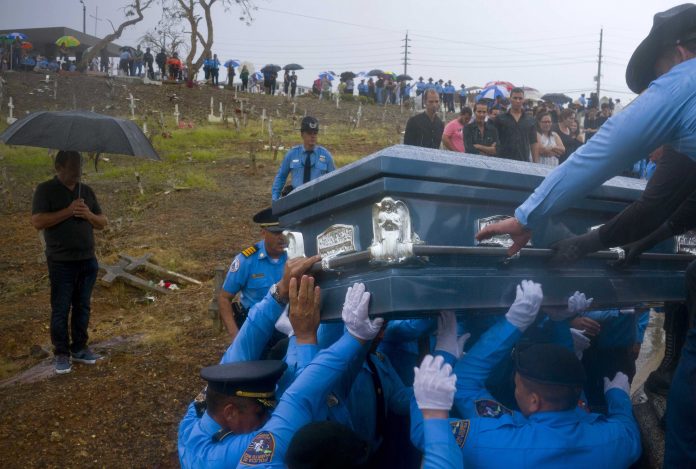U.S. researchers who estimated that nearly 3,000 people died in Puerto Rico in the aftermath of Hurricane Maria are now investigating deaths that might have been missed and could be linked to infrastructure damaged by the Category 4 storm, officials announced Wednesday.
The Milken Institute of Public Health at George Washington University received a nearly $1 million contract from the National Institute of Standards and Technology for the investigation. University officials said the project seeks to improve the death certification process and building standards across the U.S. mainland ahead of future storms as part of a collaboration with the University of Puerto Rico and others.
The investigation also aims to identify all direct and indirect deaths linked to building and infrastructure failures in the first two weeks after Maria struck on Sept. 20, 2017, including finding clusters of deaths tied to critical facilities such as hospitals and schools.
Yaritsa Santiago, whose mother died after she was airlifted from Puerto Rico to Miami shortly after Maria struck, praised the upcoming investigation and said she was encouraged that the storm-related deaths will not be in vain. Her mother had been scheduled to undergo an operation for heart problems in October that was indefinitely postponed as a result of the hurricane.
“I think it’s fantastic they’re creating this awareness,” Santiago, who lives in Tampa, said in a phone interview. “A lot of people had to leave Puerto Rico and died elsewhere…Following up is very important to avoid this happening in the future.”
It is one of four projects that studies the impact of Hurricane Maria in Puerto Rico and launched by the National Institute of Standards and Technology, a non-regulatory agency within the U.S. Department of Commerce. The $5 million investigation is only the fourth one conducted by the institute. The others focused on the World Trade Center towers, a Rhode Island nightclub fire and the 2011 tornado that hit Joplin, Missouri.
“This isn’t a traditional research project,” Judith Mitrani-Reiser, who leads the institution’s division overseeing the Hurricane Maria investigation, said in a phone interview.
She said that it will take several years to complete and that researchers will review government data, interview families of victims and focus on hospital, schools and shelters.
“We’re trying to understand how people died,” she said.
Carlos Santos Burgoa, a professor at the Milken Institute who will lead the project, said in a statement that he hopes it also will help experts quickly and accurately count deaths following a natural disaster.
The NIST has said it chose to study the impact of Maria in Puerto Rico over Hurricane Harvey in Texas and Hurricane Irma in Florida because of the sustained wind speeds greater than 140 mph (225 kph) across a broad region, damage from wind, flooding and landslides, loss of critical services and a prolonged recovery.
Puerto Rico’s government at the time came under heavy criticism for severely undercounting the number of deaths related to Hurricane Maria, which destroyed the power grid and caused more than an estimated $100 billion in damage. The government later raised the official death toll from 64 to 2,975 following an independent study by George Washington researchers who found that people succumbed in the sweltering aftermath and that doctors were not trained in how to classify deaths after a disaster.




















